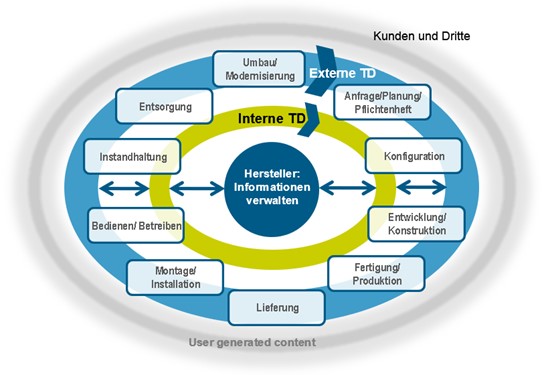Internal technical documentation
Work instructions and SOPs, quality records, requirement specifications, knowledge databases and guides all have one thing in common: only information that meets requirements and is used effectively leads to efficient processes.
Internal technical documentation - what is it?
The onion skin model of technical communication shows how external documentation – manuals, catalogs, websites – emerge from internal documentation in the product lifecycle.

Internal technical documentation includes, for example, development documents such as risk assessments, QM documents such as work instructions and guidelines, and quality records, such as inspection checklists and log files.
Good internal documentation is a basic prerequisite for developing external documentation that meets requirements and is efficient at the same time.
Here, the rules and principles for internal documentation are similar to those for external documentation: information must be easily accessible, up-to-date and correct, structured, understandable, minimalist, and applicable.
Editorial Guide
Without the written rules of a living editorial guide, quality goes down the drain. The editorial guide is the basis for training and quality assurance and serves as a reference work for everyday work. And not only that, an editorial guide is the knowledge management of a technical editing department!
Technical newsrooms are becoming more professionalized and creating specialized roles for increasing tasks:
- Product and target group research, standards and requirements management
- Structure of information products (document types) and information types for different product areas
- Formulation and syntax
- Terminology management
- Illustration and media production
- Modularization, classification, and metadata
- Quality assurance, reviews, and proofreading
- Translation management
- Creating warning signs or software texts
- and much more
To the same extent, the need for regulation is also increasing.
Editorial guidelines can be created and maintained as a wiki or in the editorial systems themselves. With clear responsibilities and rules, they are updated on a daily basis: Meeting results do not have to be temporarily stored in minutes but are available to the editorial team promptly. Only if the rules are up to date, can the editorial guide create the necessary resilience.
What we do
Together with the editorial team, we develop standards that are based on the actual work processes of technical editors and optimally support their work. In doing so, we also use our Functional Design method.
We are not reinventing the wheel: many proven rule modules from over 80 existing guides can be used with the necessary adaptations.
Guide for administration departments in case management
Large administration departments often have to handle thousands of pieces of customer correspondence. But which text module is the right one for which case? And isn't this a special case that needs to be reformulated?
A case management guide needs to focus on effectively supporting the people who need to work with the guide: Their tasks and ways of working must be carefully examined and understood.
Knowledge bases, requirements, and quality records are often created or edited by many different authors. To achieve the required consistency and effectiveness, clear standards and working tools are needed:
- Clear designations and clear terminology
- Standardized structures that are oriented to the work process and information needs
- Functional formulation patterns
- Templates and text examples
What we do
In close cooperation with the process owners, we develop structures for internal documentation that meet requirements. We establish writing rules and formulate examples. We define a terminology process and a basic vocabulary. We train the authors of internal rules and guidelines and develop a document creation and release process.
If necessary, we introduce an authoring system that fits the requirements.
Work instructions
The quality of work instructions has a direct impact on the productivity and effectiveness of a company, whether for manufacturing, a laboratory, or in the field.
Work instructions must be up-to-date, clear, understandable, and safe. In terms of quality requirements, they are therefore similar to instructions for products. Safety aspects, work steps for a specific workplace, focusing only on essential information ("minimalism"), unambiguous terminology, clear text-image relationships, and also compliance with standardized structures are all important requirements for work instructions.
What we do
Based on existing standards, we create clear rules and structures for work instructions. An style guide regulates how work instructions are formulated, created, illustrated, and distributed.
All authors are trained to work with the guide.